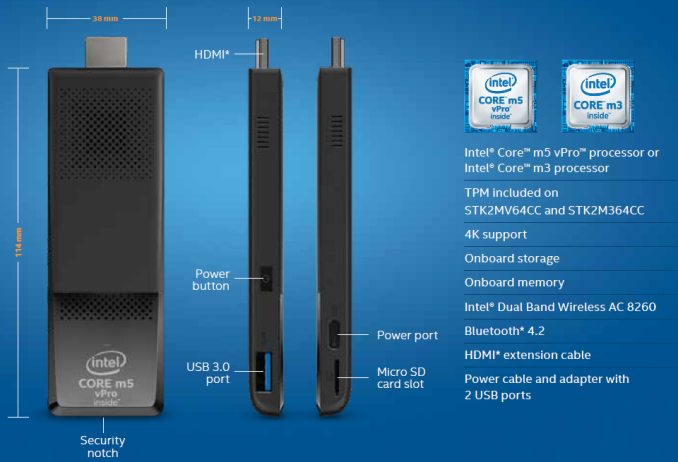The Intel Compute Stick (Core m3-6Y30) Review
by Ganesh T S on June 27, 2016 8:00 AM EST- Posted in
- Systems
- Intel
- Core M
- Skylake
- HDMI Stick
- Compute Stick
Miscellaneous Aspects and Concluding Remarks
Intel has also been putting some effort on the software side for the Compute Stick platform. One of the main problems with the platform is the limited availability of USB ports. This is somewhat alleviated in the Core M version, thanks to the two USB 3.0 ports in the power adapter. In certain situations (such as the 'entertainment' use-case), the consumer often has a second screen available (either a tablet or a smartphone). Intel has a free Android / iOS app - the Intel Remote Keyboard - to take advantage of the second screen.
The host application comes pre-installed on the Compute Stick and is active at startup as a service. Therefore, one can use it to even enter credentials for system login. It allows the second screen keyboard to act as the primary keyboard for the Compute Stick and the screen itself to act as a trackpad for the mouse pointer on the Compute Stick's display. In our evaluation, the app worked well. Our only wish is for the in-built keyboard in the app to have a 'Tab' key, and the keyboard to work properly when using a Powershell or Command Prompt window.
Moving on to the business end of the review, we complained in our previous Compute Stick reviews that 32GB of primary storage does not cut it on any computing device other than a tablet or smartphone. Fortunately, the Core m3-6Y30 Compute Stick solves that problem. The two USB 3.0 ports on the power adapter are very welcome. The Wi-Fi solution (2x2 AC8260 802.11ac PCIe WLAN) is also top-notch. The system is also able to bitstream HD audio for HTPC applications. BIOS options t have fine-grained control over the fans is also a nice aspect. Performance-wise, it is hard to find faults when keeping the form factor in mind.
The only complaint we have is the $390 price point. Even though that price includes the OS license, we find it difficult to recommend it in the home PC market - the Cherry Trail Compute Stick and the other sub-$150 Compute Sticks look to be a better option.
However, the SMB / enterprise market might find the Core M Compute Sticks more to their liking. Price is not such a huge deterrent in that market. The availability of vPro features (in the Core m5 model) and TPM (trusted platform module) shows that Intel intends these systems to be primarily adopted in that market segment.











105 Comments
View All Comments
jaydee - Monday, June 27, 2016 - link
Until this thing can get power over HDMI, I just can't see these going far.nathanddrews - Monday, June 27, 2016 - link
HDMI doesn't offer the power required to charge a phone, let alone peak usage from a Chromecast. I think you meant MHL/SuperMHL?lilmoe - Monday, June 27, 2016 - link
My next TV will have USB-C ports, that's for sure. Fully featured ones at that.jaydee - Monday, June 27, 2016 - link
Just in general, until this type of device can drop the power adapter, I don't see how it's form-factor (sticking out of a TV) is that much of an advantage over something that sits on the desk. Whether it's HDMI or some other standard.Murloc - Monday, June 27, 2016 - link
also sticking out of the TV poses various issues.I think it's a dumb format, if you have a power brick and cable laying around anyway, it doesn't make a difference to have it attached to the TV or lying on the floor.
mkozakewich - Monday, June 27, 2016 - link
They'll be USB C with DisplayPort passed through. Either the TV will act as a USB hub, or you could connect a USB hub between the dongle and the TV to get access to ports.The_Assimilator - Monday, June 27, 2016 - link
"Small and power-efficient computers in the form of NUCs and Compute Sticks have emerged as bright spots in the PC market over the last few years."Then Intel canned Atom and that bright spot went away. The Atom compute sticks were already on the edge of affordability, these Core M models are more than twice the price and thus make exactly zero financial sense unless you absolutely need x86.
RIP compute stick, we hardly knew you.
Gunbuster - Monday, June 27, 2016 - link
Even the best atom was at the edge of "oh I think this performance might be okay this time around, and then you load it up in real world multi app workload and it slows to a crawl"If they moved Core M pricing into the world of sanity everything would be perfect.
beginner99 - Monday, June 27, 2016 - link
Yeah but that was probably due to only 2GB of ram and slow storage. 2GB is just not enough.Gunbuster - Monday, June 27, 2016 - link
I've got a Asus Atom powered T100HA with 4GB. Doesn't make a difference. Once you have a real workload like OneDrive, Dropbox, Skype, OneNote, Chrome, Outlook running is starts to lag. It's not pegging out the RAM or Storage, It just struggles that little bit in everything and it gets really frustrating.